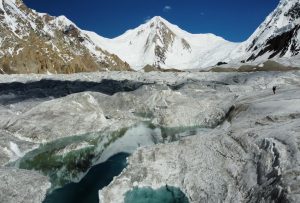Climbers often ask me about the best weather window in July and August in the Karakorum, specifically for K2.
During June and July, warm, moist air from the Bay of Bengal slowly moves toward the Karakorum. Although this incoming warm air is cooler than the continental air mass, it holds more water vapor. This creates the northward-driving, legendary annual phenomenon known as the South Asia or Indian monsoon.
Monsoonal storms first drive up the rapid incline along the Himalaya, often leading to heavy rain, thunderstorms and snow at higher elevations. Later in the summer, this moisture finally reaches Pakistan.

South Asian Monsoon
Near the end of July, the polar jet stream moves north, and the monsoon slides north with it to the Tibetan highlands. The subtropical jet stream also shifts well south of the Karakorum. In between the two, summer winds are generally lighter.
Typically, the best climbing weather in the Karakorum is around the last two weeks of July. Some years, it begins as early as mid-July and may last into early August. High temperatures, wind and precipitation all lessen during this time. This weather window has been known since the Italians first summited K2 on the last day of July, 1954.
Bad weather can still set in during this normally pleasant period. In the three decades between 1986 and 2016, 12 years (39%) featured no summits because of poor weather in the last half of July. A summit window can take place at two times: Before the monsoon reaches its northern limit in Pakistan, and when it slowly starts to retreat from those positions.

What is typical summer weather in the Karakorum? This site illustrates some general weather patterns around Broad Peak. At 5,000m on Broad Peak, mean daily highs reach around 8°C around the end of July and don’t begin to fall until the end of August. Mean daily minimums drop to -1.5°C. July and August tend to be the driest months.
Meteorologist Geoff Linsley contributed to this article.





